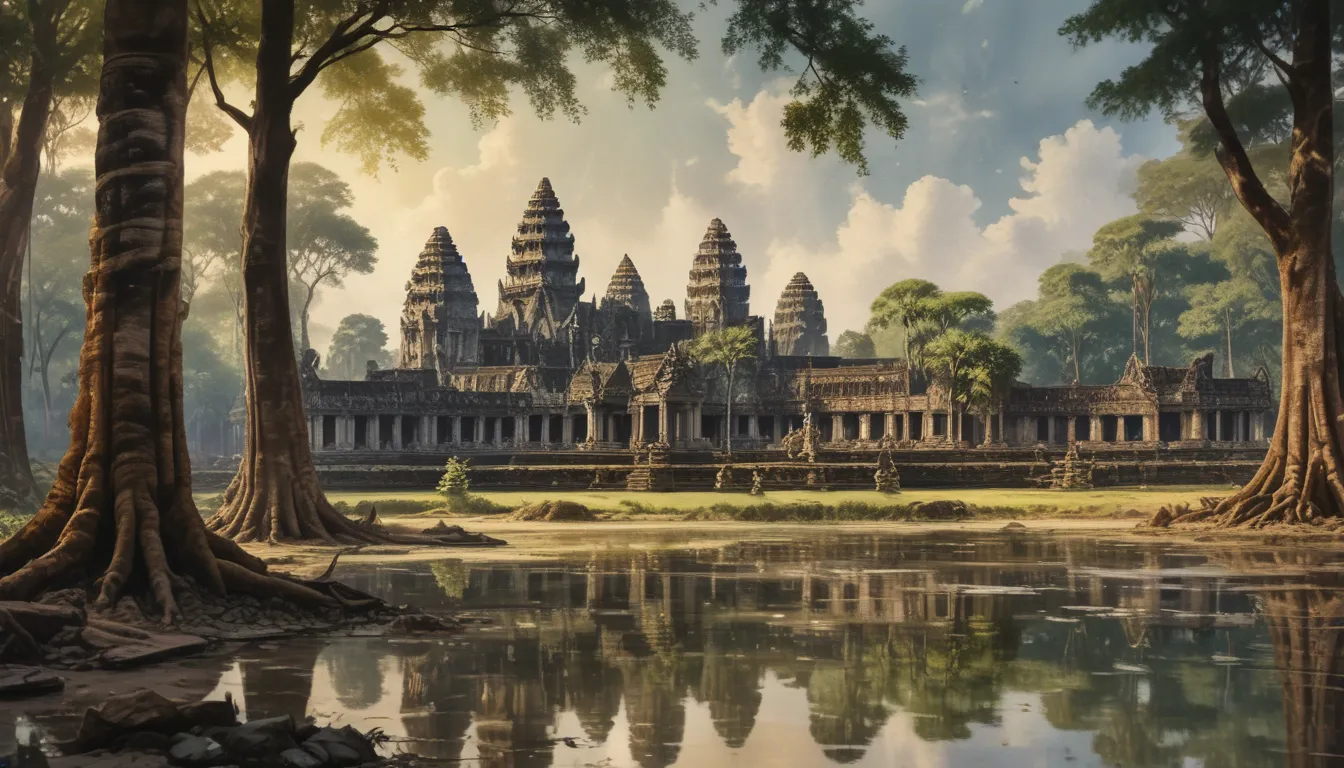The images in our articles are for illustrative purposes only and may not exactly match the content. They are intended to capture your interest and complement the text, not to replace it.
Are you ready to embark on a journey through time and unravel the mysteries of a truly remarkable masterpiece? Angkor Wat, located in Siem Reap, Cambodia, is a symbol of national pride and a must-see destination for tourists worldwide. With its rich history, intricate carvings, and spiritual significance, this ancient temple complex continues to captivate millions of visitors each year. Join us as we delve into 19 mind-blowing facts about Angkor Wat that will leave you in awe of its incredible beauty and cultural importance.
Unveiling the Architectural Marvel
Angkor Wat stands as a testament to the architectural and artistic achievements of the Khmer people. Designated as a UNESCO World Heritage site, this awe-inspiring temple complex in Cambodia mesmerizes visitors with its grandeur and intricate design.
Journey through Khmer Civilization
As a symbol of the Khmer empire’s golden age, Angkor Wat reflects the architectural and artistic prowess of its people. Flourishing from the 9th to the 15th century, the Khmer civilization left behind a legacy of monumental structures that continue to amaze us to this day.
Spellbinding Scale and Size
Covering a sprawling area of approximately 400 acres, Angkor Wat is the largest religious monument ever constructed. Its sheer size and complexity showcase the remarkable engineering skills of the Khmer civilization, leaving visitors in awe of its magnificence.
The Evolution of Faith
Initially built as a Hindu temple dedicated to the god Vishnu, Angkor Wat underwent a transformation into a Buddhist temple in the 14th century. This blend of religious traditions adds a unique dimension to the temple’s cultural significance and historical importance.
Symbolism in Stone
Angkor Wat’s layout is a visual representation of Mount Meru, the mythical home of Hindu gods. The central tower symbolizes the mountain peak, surrounded by galleries and moats that depict oceans and continents, infusing the temple with profound symbolism.
Testimony of Time
Despite enduring natural disasters, wars, and the ravages of time, Angkor Wat remains a testament to Cambodia’s rich cultural heritage and resilience. Its enduring beauty and historical significance make it a cherished treasure for generations to come.
Celestial Alignments
Believed to be aligned with significant celestial events like equinoxes and solstices, Angkor Wat served not only as a place of worship but also as an astronomical observatory. This mystical aspect adds another layer of intrigue to the temple’s ancient allure.
The Apsara Dance Legacy
The iconic Apsara dance, a graceful and intricate traditional Cambodian dance, is said to have originated from the carvings found in Angkor Wat. Depicting heavenly nymphs, this dance form continues to enchant audiences with its beauty and grace.
Cultural Icon in Cinema
Angkor Wat’s majestic allure has made it a popular filming location for movies, documentaries, and video games. Its timeless beauty and grandeur have captured the imagination of filmmakers and audiences worldwide, showcasing its universal appeal.
Each Step Tells a Story
With millions of tourists flocking to Angkor Wat each year, it has become one of Southeast Asia’s most visited sites. Its rich history, awe-inspiring architecture, and spiritual ambiance make it a destination that promises a journey of discovery and wonder.
Harmony with Nature
Angkor Wat not only preserves cultural and historical treasures but also serves as a sanctuary for diverse flora and fauna. The surrounding forests and water bodies are home to a variety of species, creating a harmonious ecosystem that adds to the temple’s allure.
Sacred Grounds for Pilgrims
For Buddhists and Hindus, Angkor Wat holds deep religious significance as a site for pilgrimage, blessings, and spiritual reflection. Devotees from around the world travel to this sacred place to seek solace and connect with their faith.
Commemorating Tradition
During Angkor Wat’s annual “Visak Bochea” celebration, thousands gather to honor the birth, enlightenment, and passing of Buddha. This vibrant event showcases Cambodia’s religious traditions and cultural heritage in a colorful and meaningful manner.
Preserving the Past
Dedicated efforts are ongoing to safeguard, restore, and protect Angkor Wat from the effects of time and tourism. Conservation projects and regulations are in place to ensure that this cultural and historical treasure remains intact for future generations to cherish.
National Heritage and Pride
Angkor Wat symbolizes more than just a remarkable monument; it stands as a source of national pride for the people of Cambodia. Representing their rich heritage and enduring spirit, the temple embodies the cultural legacy of the nation.
Captivating Sunrises and Sunsets
Witnessing the breathtaking sunrise and sunset at Angkor Wat is a must for visitors seeking a truly magical experience. The changing hues of the sky against the temple’s silhouette create a mesmerizing backdrop that highlights its beauty and grandeur.
Delve Deeper into the Wonders of Angkor Wat
Whether you’re an adventurer, history buff, or architecture enthusiast, Angkor Wat offers a treasure trove of discoveries waiting to be explored. From its ancient mysteries to its intricate craftsmanship, a visit to this extraordinary temple complex promises an unforgettable journey of enlightenment and wonder.
FAQs – Your Guide to Angkor Wat
-
Age of Angkor Wat: Built in the early 12th century, Angkor Wat dates back to the reign of King Suryavarman II between 1113 and 1150 AD.
-
Size of Angkor Wat: Spanning approximately 162.6 hectares (402 acres), the central temple complex alone covers an area of about 1 square kilometer.
-
Number of Temples: Angkor Wat comprises not just one temple but a vast complex of numerous temples, including the iconic Angkor Wat temple, Angkor Thom, Bayon, Ta Prohm, and more.
-
Significance of Angkor Wat: As a UNESCO World Heritage site, Angkor Wat holds great archaeological and cultural importance in Southeast Asia. It serves as a symbol of national pride for Cambodia and showcases the grandeur of Khmer architecture.
-
Climbing Angkor Wat: Visitors are allowed to climb to the top of Angkor Wat, though the steep staircase can pose a challenge. Safety precautions and mindful climbing are advised for a memorable experience.
-
Largest Religious Monument: Angkor Wat proudly holds the title of the world’s largest religious monument, a testament to the Khmer civilization’s skill and artistry.
-
Ideal Time to Visit: The dry season from November to March offers ideal weather conditions to explore Angkor Wat, with clear skies and pleasant temperatures for an immersive temple experience.
Embark on an Unforgettable Journey
As you plan your next travel adventure, consider adding Angkor Wat to your bucket list. Its timeless beauty, cultural heritage, and architectural marvels await your discovery, promising a journey of enlightenment and wonder. Capture the magic of Angkor Wat through your lens and heart, as you immerse yourself in the legacy of the ancient Khmer civilization.
Journey with Us
Our commitment to delivering authentic and engaging content is driven by a passion for sharing the wonders of the world with you. Each fact and insight is contributed by real users like you, ensuring a diverse and credible wealth of information. Trust in our dedication to quality and authenticity as you journey through the fascinating realms of history, culture, and architecture. Explore, learn, and discover with us as we unravel the mysteries of the past and celebrate the beauty of our shared heritage.






